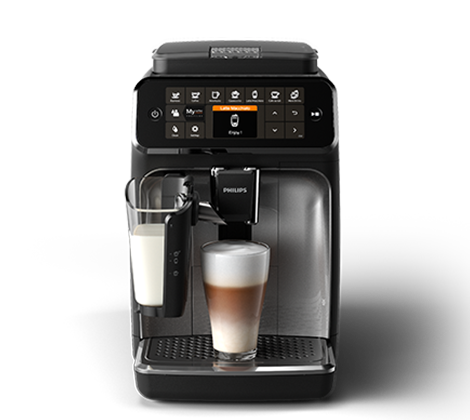#1: Philips 3200

- Easy to use
- Affordable
- Compact design
#2: Philips 4300

- More drink options
- Intuitive touchscreen
- Customizable settings
As someone who takes their coffee seriously, I’ve spent a lot of time experimenting with different coffee machines to perfect my daily brew. Two models that really stood out to me are the Philips 3200 and Philips 4300. Both are solid choices for anyone looking to upgrade their coffee game, but after spending weeks using both, I’ve come to appreciate the Philips 4300 for its superior features and versatility. Let me walk you through the details and my personal experience with both machines, so you can make the best decision for your coffee needs.

Key Differences Between Philips 3200 and Philips 4300
One of the first things I noticed when comparing the Philips 3200 and Philips 4300 is how similar they appear at first glance. However, when you dive into the details, the differences become clear. The Philips 4300 offers more beverage options, user profiles, and a more advanced user interface, which really enhances the overall experience.
That said, the Philips 3200 is by no means a bad machine. In fact, it delivers high-quality coffee with minimal effort and offers great value for its price. But if you’re someone who appreciates having control over every aspect of your coffee preparation (like I do), the Philips 4300 has a few extra tricks up its sleeve.
Performance in Daily Use
When I first started using the Philips 3200, I was immediately impressed by how easy it was to use. The touch panel is intuitive, and it only took a couple of minutes to familiarize myself with the controls. Whether I was making an espresso or a cappuccino, the process was seamless.
However, the Philips 4300 elevated my coffee experience further. Its advanced TFT color display is not only more visually appealing but also makes navigating the machine’s settings feel effortless. I particularly appreciated how the display provided feedback on every step, like reminding me when to refill the water or adjust the coffee strength.
Another big win for the Philips 4300 is its ability to save multiple user profiles. This feature proved invaluable in my household, where everyone has different coffee preferences. With a quick tap, I could switch from my bold morning espresso setting to my partner’s frothy cappuccino profile. The Philips 3200 lacks this functionality, so every time I used it, I had to manually adjust the settings—a minor inconvenience, but noticeable.
Coffee Quality: Philips 3200 vs 4300
Let’s talk about what really matters: the coffee. Both machines consistently deliver flavorful and aromatic coffee, but the Philips 4300 has the edge in terms of variety and customization.
With the Philips 3200, you can choose from five beverages, including espresso, cappuccino, and latte macchiato. These options cover the basics and deliver excellent results. But the Philips 4300 goes a step further with eight beverage options, including ristretto and café crema. As someone who enjoys experimenting with different styles of coffee, I found the additional variety refreshing.
I also noticed that the Philips 4300 gives you more control over the strength and temperature of your coffee. The machine’s five aroma strength settings allowed me to fine-tune my brew to suit my mood—whether I wanted a bold kickstart to my day or a lighter afternoon pick-me-up. The Philips 3200 only offers three aroma settings, which feels a bit limiting in comparison.

Cleaning and Maintenance: A Breeze with Both Models
One thing I really appreciated about both machines is how easy they are to clean. The LatteGo milk system, in particular, is a standout feature. It’s designed with just two parts and no tubes, making it incredibly easy to rinse and maintain.
The removable brew group is another thoughtful touch. Both the Philips 3200 and Philips 4300 allow you to pop out the brew group and rinse it under running water—a simple process that ensures your machine stays in top condition.
That said, the Philips 4300 slightly edges out the Philips 3200 in this department thanks to its more detailed maintenance prompts on the display. I found these reminders helpful for staying on top of descaling and cleaning tasks, especially since I tend to forget about these things when life gets busy.
Who Should Choose the Philips 3200?
If you’re new to automatic coffee machines or looking for a straightforward solution, the Philips 3200 is a fantastic entry point. It’s easy to use, delivers consistently good coffee, and doesn’t overwhelm you with too many features.
I would recommend the Philips 3200 to anyone who primarily drinks the classic espresso, cappuccino, or americano and doesn’t need the bells and whistles of more advanced machines. It’s also a great choice if you’re working with a tighter budget but still want a high-quality coffee maker.

Why the Philips 4300 is the Better Choice for Me
For me, the Philips 4300 offers the perfect balance of simplicity and sophistication. The additional beverage options, user profiles, and advanced customization features make it a joy to use daily.
One feature I didn’t realize I needed until I had it was the ability to create and save personalized coffee settings. This is a game-changer if you’re sharing the machine with family members or roommates, as everyone can have their ideal cup at the touch of a button. It’s small conveniences like this that make the Philips 4300 feel worth the investment.
Another reason I prefer the Philips 4300 is the enhanced control over coffee strength and temperature. As someone who likes experimenting with different brewing styles, I loved being able to fine-tune every detail of my cup. It’s the kind of feature that makes the difference between “good coffee” and “amazing coffee.”
Additional Features I Loved in the Philips 4300
Beyond the basics, the Philips 4300 has a few extra features that enhance the overall experience. For instance, the hot water function came in handy for brewing tea or pre-heating my coffee cups. While the Philips 3200 offers this feature as well, the 4300’s interface made it easier to access.
Another subtle but useful feature is the quieter operation of the Philips 4300 during milk frothing. This might not seem like a big deal, but when you’re making coffee early in the morning, every decibel counts!
Product Review Conclusion: Philips 3200 vs 4300
After weeks of hands-on testing, I can confidently say that both the Philips 3200 and Philips 4300 are excellent coffee machines. They deliver high-quality coffee with minimal effort and are packed with user-friendly features.
However, the Philips 4300 takes the lead for me due to its expanded beverage options, advanced customization settings, and user profiles. It’s a versatile machine that caters to a wider range of coffee preferences, making it ideal for households with multiple coffee drinkers or for anyone who enjoys experimenting with different flavors and styles.
That said, the Philips 3200 is a great option if you’re looking for a more budget-friendly choice that still delivers excellent coffee. It’s reliable, easy to use, and perfect for those who don’t need all the extra features.
Ultimately, your choice will depend on your needs and priorities. If you’re like me and value customization, versatility, and advanced features, the Philips 4300 is the way to go. But if simplicity and affordability are your main concerns, the Philips 3200 won’t disappoint.
Frequently Asked Questions
1. What is the main difference between the Philips 3200 and the Philips 4300?
The main difference lies in the features and customization options. The Philips 4300 offers eight beverage options compared to five in the Philips 3200, along with advanced user profiles, a color TFT display, and more aroma strength settings for a personalized coffee experience.
2. Are both machines easy to clean?
Yes, both the Philips 3200 and Philips 4300 are designed for easy cleaning. They feature a removable brew group and the LatteGo milk system, which has only two parts for quick rinsing. Regular maintenance is straightforward, thanks to clear instructions on the display.
3. Can I save my coffee preferences on the Philips 4300?
Absolutely! One of the standout features of the Philips 4300 is the ability to create and save multiple user profiles, allowing different users to save their preferred coffee settings for quick access.
4. Do both machines have a hot water function?
Yes, both the Philips 3200 and 4300 have a hot water function, which is useful for making tea or pre-heating cups. However, the 4300’s interface makes it easier to access this feature.
5. Which machine is quieter during operation?
While both machines operate quietly compared to many others, the Philips 4300 tends to be slightly quieter, especially during the milk frothing process, making it a better choice for early morning coffee-making.
6. Is there a significant price difference between the Philips 3200 and the Philips 4300?
Yes, the Philips 4300 is typically priced higher than the Philips 3200 due to its advanced features and additional beverage options. However, many users, including myself, find that the extra investment is worth it for the enhanced coffee-making experience.
7. Can I adjust the strength and temperature of the coffee in both models?
Both machines allow you to adjust the coffee strength, but the Philips 4300 offers five aroma strength settings compared to three in the 3200, giving you more control over the flavor. Temperature adjustments are generally preset but effective in both models.
8. Which machine would you recommend for beginners?
For beginners, the Philips 3200 is an excellent choice. It’s user-friendly, delivers quality coffee, and has a simpler interface. The Philips 4300 is more suited for those who want to explore more customization and variety in their coffee choices.
9. What types of beverages can I make with the Philips 3200?
With the Philips 3200, you can make five types of beverages: espresso, coffee, cappuccino, latte macchiato, and americano.
10. How long does it take to brew a cup of coffee with these machines?
Both machines brew coffee quickly, typically taking just a few minutes from start to finish. The exact time may vary slightly based on the beverage type and settings you choose.
